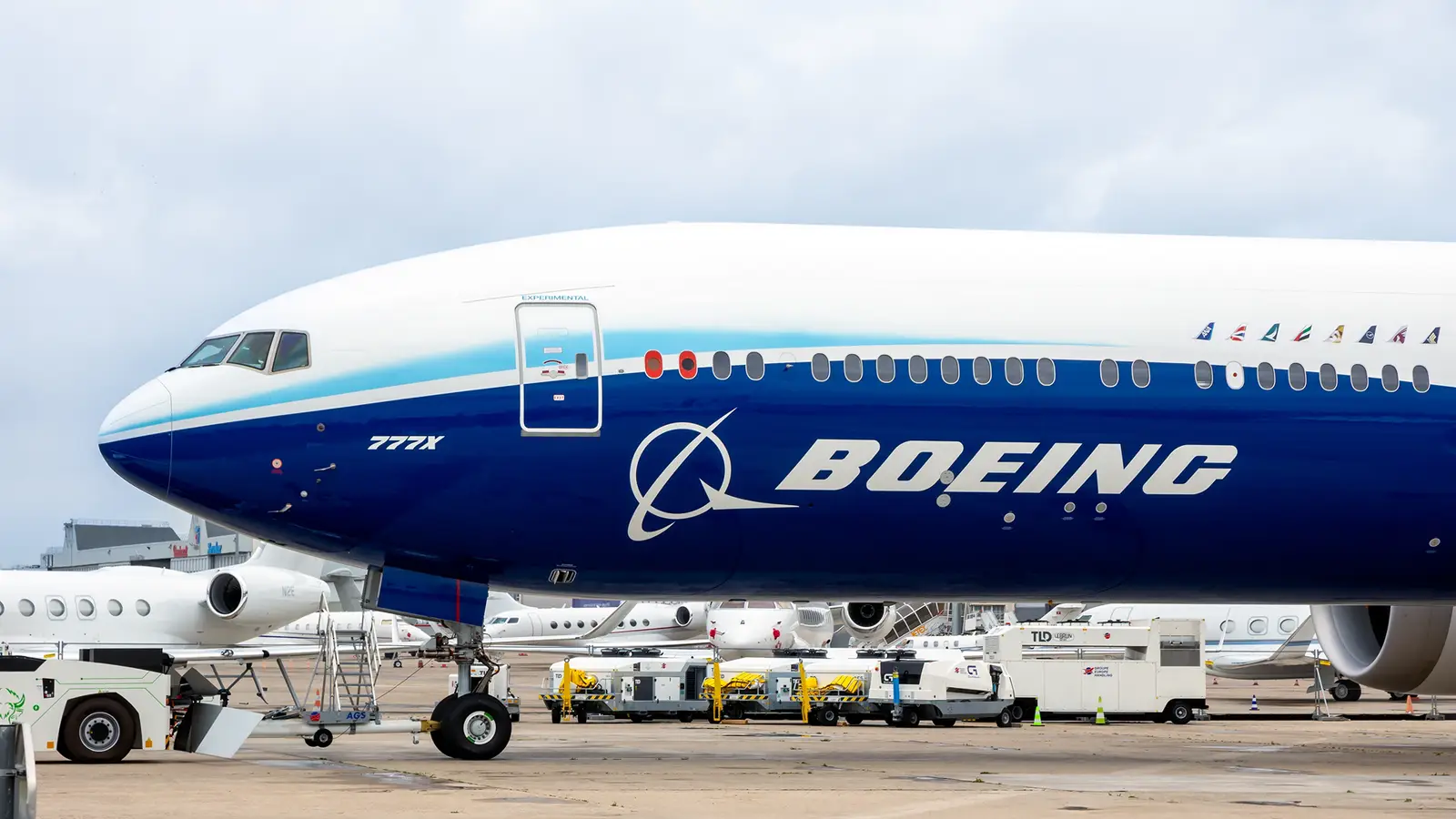
What continues to be a never-ending saga for American plane maker, Boeing, the light at the end of the tunnel continues to feel a while away, with the Boeing 777X certification still looming. Boeing has come out recently, acknowledging that it may not fully be on track for certification, putting the airplane’s expected delivery and entry date of 2026 in jeopardy.
Boeing Chief Executive Officer, Kelly Ortberg, noted to Reuters on Thursday, that the American planemaker is currently ‘behind schedule on certifying the 777X’, with the maker expected to deliver its first airplane in 2026, six years later than was initially planned (2020), when first announced back in 2013.
The 777X Program
Boeing’s 777X is the latest in long-range widebody aircraft. The aircraft was following on from the success of the 777, and would include General Electric GE9X engine, folding wingtips (meaning better range, but the ability to operate at standard 777 airports), and composite wings. A wider cabin and heavier seating capacity are set to wow travelers, paired with state-of-the-art technologies, as already seen with the Boeing 787 Dreamliner.
The 777X was first launched back in November 2013, and was set to have two variants, the 777-8 and 777-9. The -8, a slightly smaller version, could have a range of up to 8,745 nautical miles (16,196 km), whereas the 777-9, which could seat more passengers, has a shorter range of 7,285 nautical miles (13,492 km). The 777-8 could seat 395 passengers, whereas 426 can be squeezed onto the 777-9.
With more than 600 total orders for the airplane type, including passenger and freighter combinations, it is currently on hold for multiple customers, including Dubai-based Emirates, which has had to rejuvenate some of its aging Airbus A380s in a bid to fill the gap required until the delivery of the 777X. Boeing plans to have the 777X flying in 2026, with delivery of the first airplane expected to be to the German flag carrier, Lufthansa.
What’s The Delay This Time?
As explained by Ortberg, there are still a lot of boxes to tick to ensure the aircraft is ready for certification. The American plane maker CEO was quick to clarify that there are no current technical problems, as detailed during a speech at the recent Morgan Stanley’s 13th Laguna Conference, held on 12 September 2025, in Laguna Beach, California.
Boeing has already lost billions of dollars on the beleaguered program, noting that inflationary pressures have affected the success of the 777X, with supply chain pressures affecting the aircraft’s pricing. Even minor schedule delays on the plane could have huge financial impacts. The supply chain constraints currently faced by Boeing, fortunately, have not seen an increase in cost to the 737 MAX.
The Seattle-based plane maker remains laser-focused on paying down debt to ensure Boeing can return to profitability, with the manufacturer taking on additional debt due to recent crises over the last decade. President Trump has influenced many major economic partners to buy Boeing airplanes, as it looks to ‘reset’ trade relations with international allies. This has resulted in Asian countries, such as Japan and South Korea, ordering dozens of Boeing aircraft as part of these negotiations.
Working With The Federal Aviation Administration
Boeing hopes to get the 777X certified in early 2026, paving the way for its first deliveries before the end of the year. However, preparing for the Federal Aviation Administration to sign off on the aircraft’s airworthiness will be a mountain to climb, but Boeing is prepared.
Once certified, the 777X will become the world’s largest twin airliner, and the biggest commercial airplane now in active production (following the wind-down of the Airbus A380 in December 2021). The presence of the 777X, once airborne, will enable airlines to retire their aging widebody, potentially double-decker aircraft, for a more economic alternative, fit for today’s requirements of modern aviation. Details of the 777X specifications below:
Since the COVID-19 pandemic, many airlines’ fleet plans were thrown into chaos, as many opted to retire many of their aging aircraft. This has come back to haunt some carriers, as the post-pandemic revival of international travel has made the industry boom once again, resulting in supply chain challenges and soaring fleet demands.
Design Parts & Quality Problems
So far, the 777X programme has been held up by design issues and quality control problems, which have been widely published. An uncommanded pitch event, which was identified in 2020 during a test flight, sent the airplane’s delivery dates into orbit when the aircraft’s nose pitched up and down, without any pilot input.
This caused significant delays in the airplane’s certification process, alongside highlighted issues with the flight control system and the software it uses. This saw Boeing find the need to solve these issues quickly, before the plane had any chance of gaining certification or even thinking of commencing deliveries.
These incidents raised immense scrutiny over the 777X safety concerns. Engineers have been working around the clock to resolve the issues raised, and test flights resumed after a lengthy pause. These setbacks were a major speedbump for 777X certification, with the FAA at one point even claiming a lack of design maturity. This assessment was made through issues found on the folding wingtips, engines, and the lack of design assurance. The folding wingtips, while novel, have added complexity and additional potential failure points, to ensure they can remain secure during flight, and are not likely to lock mid-air.
Orders For The 777X
Airlines patiently awaiting the 777X are around the world, with Lufthansa set to be the official launch customer of the type. Lufthansa ordered its first batch of the airplanes back in September 2013, with a total of 20, with options for 14 more. These were for the 777-9 type. In 2022, the German carrier added an additional seven 777-8F, to support its cargo operations.
Lufthansa plans to utilize the 777X as a replacement for its aging Boeing 747s, given the airplane’s superior fuel efficiency and ability to operate the carrier’s wide-ranging long-haul international routes. The enhanced passenger comfort and ability to carry more cargo saw the German carrier opt for the 777-9 to give it a competitive edge in the highly congested European and long-haul market.
As already mentioned, Middle Eastern carrier Emirates is counting on the 777X to become a suitable replacement for its aging Airbus A380s, with more than five separate orders for the airplane, totaling 240 of the type. The airline has a mix of both the 777-8 and 777-9 planned to enter the fleet, with orders taking place between November 2014 and November 2023. A list of the five largest orders for the 777X, as noted below, with data from ch-aviation:
It is worth noting that some airlines have also canceled aircraft orders, including Emirates, which shaved off 55 from its initial plans, while airlines such as All Nippon Airways, which has an order for 20 777-9, have adjusted two of its orders to be for the 777-8F. There are also up to 20 aircraft that have been ordered for unidentified customers. While airlines are hopeful for the introduction of service from 2026, some airlines have already had to adjust their fleet strategies to the extended delays.
What’s Next For The 777X
Boeing is focused on getting final certification for the 777X to ensure entry into commercial service by the end of 2026. The 777-9, which will be the largest twin-engine jet, hopes to support the growing demand for point-to-point travel, a move away from hub and spoke, as more passengers look to travel direct to their preferred destination, instead of transiting through multiple airline hubs. The 777X will be able to cater to this demand, with innovative folding wingtips that can retract slightly upon arrival, enabling the airplane to fit into regular Code E airport gates.
The design features of the 777X will also hold a superior cargo capacity when compared to its closest competition, the Airbus A350-1000, which will have the ability to hold up to 48 LD3 containers, compared to 44 on the A350. This will make the aircraft hugely appealing for those looking to cash in on belly cargo space between international ports. This is crucial for airlines to prove viability, with the benefits of cargo revenue usually supporting the demand for international long-haul routes.
Unfortunately, the grounding of the 777X following testing failures has seen the airplane’s eventual introduction into regular service encounter setback after setback. This has led to major frustration from international airline customers and placed a financial strain on the American plane maker. This has cost Boeing billions of dollars in continued costs, and remains a significant concern for the manufacturer’s shareholders. The eventual introduction of the 777X to regular service and eventual delivery will be crucial for its medium-term cash flow.



